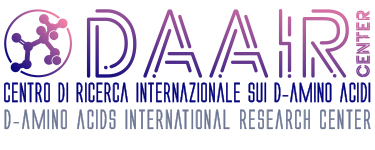
THE NEW PRESIDENT OF THE FONDAZIONE REGIONALE PER LA RICERCA BIOMEDICA
We are pleased to announce that prof. Loredano Pollegioni has been appointed President of the Fondazione Regionale per la Ricerca Biomedica (FRRB), a private law institution established by Lombardy Region in 2011, which aim is to promote and enhance scientific research in the field of Life Sciences, particularly in the biomedical field. Because of this new appointment, Loredano Pollegioni left the direction of the DAAIR center.
THE NEW DIRECTOR OF DAAIR CENTER

We are happy to announce that prof. Silvia Sacchi has been indicated as the new Director of DAAIR center.
A NEW PAPER OF DAAIR CENTER
We are thrilled that the second paper of DAAIR center has been accepted for publication. It is a review paper focusing on the presence and role of D-amino acids in foods.

- Chiral checkpoints during protein biosynthesis. The Journal of Biological Chemistry 294, 16535-16548 (November 8, 2019). doi: 10.1074/jbc.REV119.008166
This intriguing review focuses on the theme of enantiomeric fidelity in translation. Actually, cells use different mechanisms for keeping D-amino acids away from the synthesis of nascent proteins. The main factors involved in this exclusion are: aminoacyl-tRNA synthetases (aaRSs), elongation factor thermos unstable (EF-Tu), ribosomes, and D-aminoacyl-tRNA deacylase (DTD). While aaRS, EF-Tu, and ribosomes act as “chiral checkpoints” (by preferentially binding to L-enantiomers of amino acids or aminoacyl-tRNAs), DTD, is deputed to “chiral proofreading,” as it removes D-amino acids erroneously added to tRNA. This review should be read by all researchers interested in D-amino acids. MORE
- D-Aspartic Acid in Vertebrate Reproduction: Animal Models and Experimental Designs. Biomolecules 2019, 9(9), 445; https://doi.org/10.3390/biom9090445.
This interesting review from Maria Maddalena Di Fiore and collaborators focuses on the animal models and experimental designs that have been used during the past 20 years to investigate the role of D-aspartate in the reproduction of vertebrates. Results gathered on wild animals suggest a role for this D-amino acid in the mechanisms that regulate the reproductive cycle: rodent models allowed to clarify the molecular pathways activated by D-aspartate in steroidogenesis and spermatogenesis. The review also highlights the relationship between D-aspartate and reproductive activity (especially on semen quality): this allow to suggest the therapeutic use of D-aspartate in andrology and in medically-assisted procreation techniques. MORE
- Serum D-serine accumulation after proximal renal tubular damage involves neutral amino acid transporter Asc-1. Scientific Reports 9(1):16705 (November 2019) DOI: 10.1038/s41598-019-53302-2
Recent studies established that blood D-/L-serine ratio correlates with creatinine-based kidney function and thus represents a biomarker for kidney disease. In this work, the groups of Kenji Hamase and Jumpei Sasabe in Japan used a mouse model of cisplatin-induced tubular injury demonstrating that the treatment resulted in: a) tubular damage, histologically restricted to the proximal tubules; b) an increase of serum D-/L-serine ratio, with positive correlations to serum creatinine and blood urine nitrogen; c) an increase of the level of the transporter Asc-1, in renal tubules and collecting ducts, that mediates influx of D-serine preferably to L-serine. This paper sheds light on the mechanism relating kidney disease and increase in serum D-serine level. MORE
- A promising tool for cancer therapy optimized by protein engineering. Nanomedicine. 2019 Nov 6;24:102122.doi: 10.1016/j.nano.
This remarkable paper reported a potential strategy to treat solid tumors. The D-amino acids degrading enzyme D-amino acid oxidase from the yeast Rhodotorula gracilis (RgDAAO) was proposed as an ideal candidate for an enzyme prodrug therapy, based on its ability to induce cytotoxic oxidative stress through the production of the ROS species H2O2, following the local administration of D-alanine. Polyethylene glycol covalent coupling to RgDAAO was performed to promote the selective targeting and accumulation of the enzyme in tumor tissues. Moreover, the strategy was optimized by using an engineered RgDAAO variant, highly active at low oxygen and substrate concentration, and the coadministration with an inhibitor of cellular antioxidant systems. The observed cytotoxic effect on different tumor cell lines argues in favour the further evaluation of this approach in vivo. MORE
- Antimicrobial peptides conjugated with fatty acids on the side chain of D-amino acid promises antimicrobial potency against multidrug-resistant bacteria. Eur J Pharm Sci. 2020 Jan 1;141:105123. doi: 10.1016/j.ejps.2019.105123.
Nowadays, the bacterial drug resistance leads to serious health problem worldwide and makes finding new antibiotics a challenging task. Antimicrobial peptides (AMPs) are promising candidates for the development of novel antibiotics, but they generally have low antimicrobial activity and a short half-life. In this work new peptides were synthesized based on the natural AMP anoplin: residues at position 4 and 7 were substituted with the corresponding enantiomers and conjugated with fatty acids (4-16 carbon atoms). The produced peptides exhibit an excellent antimicrobial activity, especially against multi-drug resistant bacteria, and some of them showed anti-biofilm activity in addition to high selectivity for bacteria over mammalian cells. Notably, D-amino acids conferred to the peptides high stability to proteases, serum, salt and different pH. Most importantly, the improved features resulted in a remarkable in vivo antimicrobial potency, indicating the conjugation of fatty acids to D- amino acids as a suitable strategy for the design of more effective AMPs. MORE
The D-amino acids International Research Center “DAAIR“ has been established in Gerenzano (Varese, Italy) in 2019 with the aim to support and perform scientific research projects and activities on the field of D-amino acids (Director Loredano Pollegioni). The Center, located inside the Fondazione Istituto Insubrico Ricerca per la Vita, is aimed to represent a pole of excellence at international level for dissemination and research involving the D-amino acids.
The guiding principle is support the research projects aimed to investigate the involvement of D-amino acids in main physiological processes, from bacteria to humans. The ultimate goal is to actively participate to the elucidation of the mechanisms by which the D-amino acids perform specific functions, and to identify their presence and concentration in different organisms and compartments, also with regards to well-established functional states, with particular emphasis to pathological states. Understand the involvement of D-amino acids in important diseases as a way to set up novel therapeutic strategies.
Contacts: info@d-aminoacids.com;
director@d-aminoacids.com;
www.d-aminoacids.com
mailing address: info@d-aminoacids.com
Commenti recenti